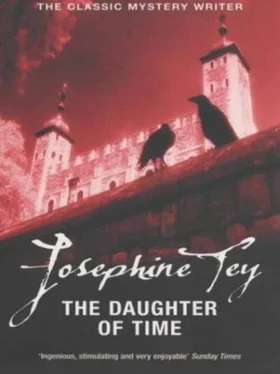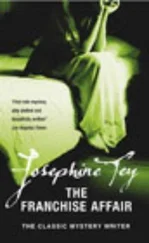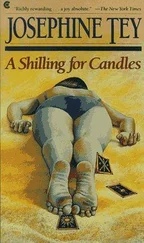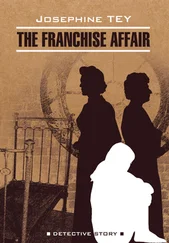Josephine Tey
THE DAUGHTER OF TIME
‘Truth is the Daughter of Time, not of Authority’
Sir Francis Bacon

Josephine Tey
Josephine Tey was one of two pseudonyms used by Elizabeth Mackintosh (1896–1952) a Scottish author best known for her mystery novels and her play Richard of Bordeaux .
She was born in Inverness, and attended a physical training college in Birmingham before becoming a teacher. Her literary career began when she was forced to give up regular work in order to care for her invalid father.
Ms Tey began to write full-time after the successful publication of her first novel, The Man in the Queue (1929), which introduced Inspector Grant of Scotland Yard. In 1937 she returned to crime writing with A Shilling for Candles , but it wasn’t until after the Second World War that the majority of her crime novels were published. She died in 1952, leaving her entire estate to the National Trust.
Josephine Tey appears as a main character in An Expert in Murder (Faber 2008) by Nicola Upson, a detective story woven around the original production of Richard of Bordeaux .
Alan Grant, Scotland Yard Inspector (who appears in five other novels by the same author) is confined to bed in hospital with a broken leg. Bored and restless, he becomes intrigued by a portrait of King Richard III brought to him by a friend. He prides himself on being able to read a person’s character from his face, and King Richard seems to him a gentle and kind and wise man. Why is everyone so sure that he was a cruel murderer?
With the help of friends and acquaintances he investigates the case of the Princes in the Tower. Grant checks historical information and documents with the help of an American researcher. Using his detective’s logic, he comes to the conclusion that the claim of Richard being a murderer is a fabrication of Tudor propaganda, as is the popular image of the King as a monstrous hunchback.
Further, the author explores how history is constructed, and how certain versions of events come to be widely accepted as the truth, despite a lack of evidence. “The Daughter of Time” of the title is from a quote by Sir Francis Bacon: “Truth is the daughter of time, not of authority.” Grant comes to understand the ways that great myths are constructed, and how in this case, the victorious Tudors saw to it that their version of history prevailed. Several other such myths are explored by the author, such as the commonly believed (but false) story that troops fired on the public at the 1910 Tonypandy Riot.
Adapted from Wikipedia and FantasticFiction.co.uk/
Grant lay on his high white cot and stared at the ceiling. Stared at it with loathing. He knew by heart every last minute crack on its nice clean surface. He had made maps of the ceiling and gone exploring on them; rivers, islands, and continents. He had made guessing games of it and discovered hidden objects; faces, birds, and fishes. He had made mathematical calculations of it and re-discovered his childhood; theorems, angles, triangles. There was practically nothing else he could do but look at it. He hated the sight of it.
He had suggested to The Midget that she might turn his bed round a little so that he could have a new patch of ceiling to explore. But it seemed that that would spoil the symmetry of the room, and in hospitals symmetry ranked just a short head behind cleanliness and a whole length in front of Godliness. Anything out of the parallel was hospital profanity. Why didn’t he read? she asked. Why didn’t he go on reading some of those expensive brand-new novels that his friends kept on bringing him.
‘There are far too many people born into the world, and far too many words written. Millions and millions of them pouring from the presses every minute. It’s a horrible thought.’
‘You sound constipated,’ said The Midget.
The Midget was Nurse Ingham, and she was in sober fact a very nice five-feet two, with everything in just proportion. Grant called her The Midget to compensate himself for being bossed around by a piece of Dresden china which he could pick up in one hand. When he was on his feet, that is to say. It was not only that she told him what he might or might not do, but she dealt with his six-feet-odd with an off-hand ease that Grant found humiliating. Weights meant nothing, apparently, to The Midget. She tossed mattresses around with the absent-minded grace of a plate spinner. When she was off-duty he was attended to by The Amazon, a goddess with arms like the limb of a beech tree. The Amazon was Nurse Darroll, who came from Gloucestershire and was homesick each daffodil season. (The Midget came from Lytham St Anne’s, and there was no daffodil nonsense about her.) She had large soft hands and large soft cow’s eyes and she always looked very sorry for you, but the slightest physical exertion set her breathing like a suction-pump. On the whole Grant found it even more humiliating to be treated as a dead weight than to be treated as if he was no weight at all.
Grant was bed-borne, and a charge on The Midget and The Amazon, because he had fallen through a trap-door. This, of course, was the absolute in humiliation; compared with which the heavings of The Amazon and the light slingings of The Midget were a mere corollary. To fall through a trap-door was the ultimate in absurdity; pantomimic, bathetic, grotesque. At the moment of his disappearance from the normal level of perambulation he had been in hot pursuit of Benny Skoll, and the fact that Benny had careered round the next corner slap into the arms of Sergeant Williams provided the one small crumb of comfort in an intolerable situation.
Benny was now ‘away’ for three years, which was very satisfactory for the lieges, but Benny would get time off for good behaviour. In hospitals there was no time off for good behaviour.
Grant stopped staring at the ceiling, and slid his eyes sideways at the pile of books on his bedside table; the gay expensive pile that The Midget had been urging on his attention. The top one, with the pretty picture of Valetta in unlikely pink, was Lavinia Fitch’s annual account of a blameless heroine’s tribulations. In view of the representation of the Grand Harbour on the cover, the present Valerie or Angela or Cecile or Denise must be a naval wife. He had opened the book only to read the kind message that Lavinia had written inside.
The Sweat and the Furrow was Silas Weekley being earthy and spade-conscious all over seven hundred pages. The situation, to judge from the first paragraph, had not materially changed since Silas’s last book: mother lying-in with her eleventh upstairs, father laid-out after his ninth downstairs, eldest son lying to the Government in the cow-shed, eldest daughter lying with her lover in the hay-loft, everyone else lying low in the barn. The rain dripped from the thatch, and the manure steamed in the midden. Silas never omitted the manure. It was not Silas’s fault that its steam provided the only up-rising element in the picture. If Silas could have discovered a brand of steam that steamed downwards, Silas would have introduced it.
Under the harsh shadows and highlights of Silas’s jacket was an elegant affair of Edwardian curlicues and Baroque nonsense, entitled Bells on Her Toes . Which was Rupert Rouge being arch about vice. Rupert Rouge always seduced you into laughter for the first three pages. About Page Three you noticed that Rupert had learned from that very arch (but of course not vicious) creature George Bernard Shaw that the easiest way to sound witty was to use that cheap and convenient method, the paradox. After that you could see the jokes coming three sentences away.
Читать дальше













